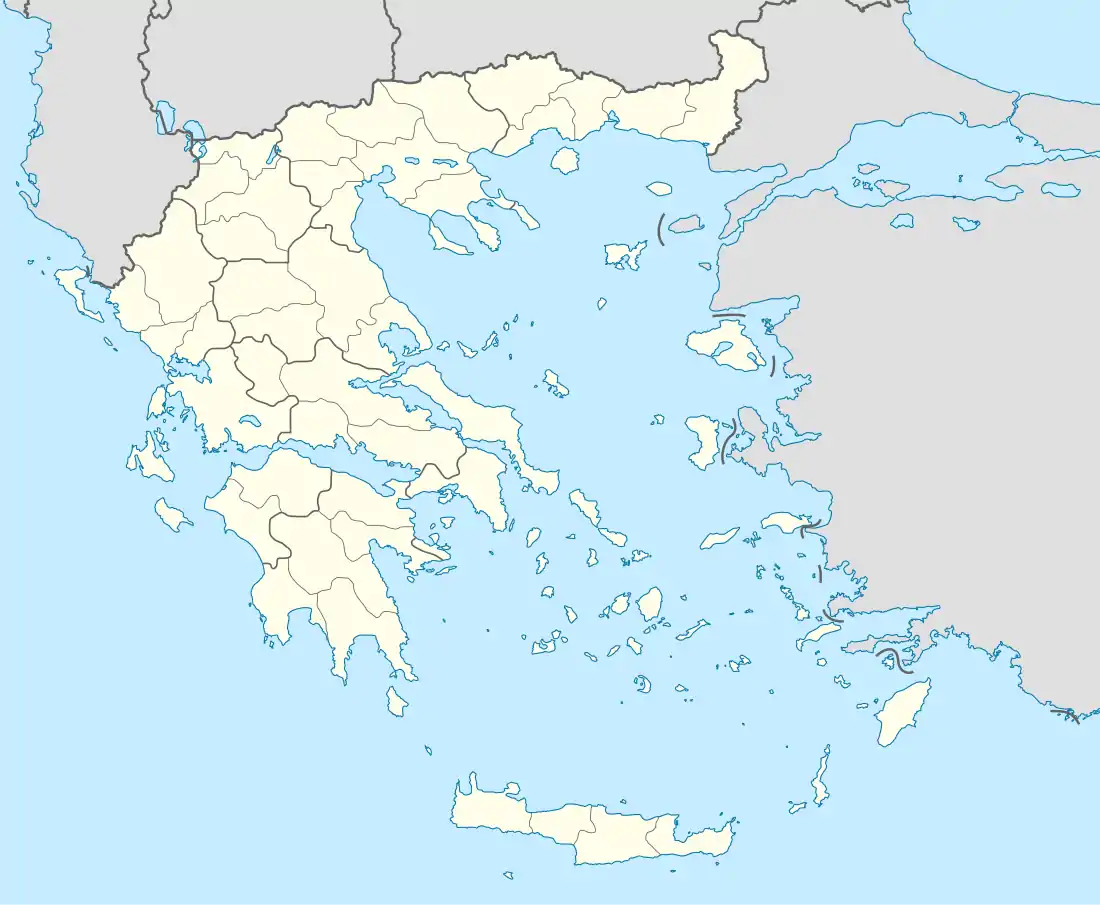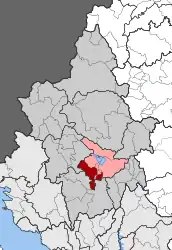Bizani
Bizani (Greek: Μπιζάνι) is a village and a former municipality in the Ioannina regional unit, Epirus, Greece. Since the 2011 local government reform it is part of the municipality Ioannina, of which it is a municipal unit.[2] The municipal unit has an area of 91.372 km2, the community 11.660 km2.[3] In 2011 its population was 5,124. The seat of the municipality was in Pedini. The municipal unit is situated in the plains and low hills south and southwest of Ioannina. The Greek National Road 5 (Ioannina - Arta), the Greek National Road 17 (Ioannina - Dodoni) and the Egnatia Odos motorway (Igoumenitsa - Ioannina - Thessaloniki) pass through the municipal unit.
Bizani
Μπιζάνι | |
|---|---|
 Bizani Location within the regional unit  | |
| Coordinates: 39°34′N 20°52′E | |
| Country | Greece |
| Administrative region | Epirus |
| Regional unit | Ioannina |
| Municipality | Ioannina |
| • Municipal unit | 91.372 km2 (35.279 sq mi) |
| Elevation | 575 m (1,886 ft) |
| Population (2011)[1] | |
| • Municipal unit | 5,124 |
| • Municipal unit density | 56/km2 (150/sq mi) |
| Community | |
| • Population | 384 (2011) |
| • Area (km2) | 11.660 |
| Time zone | UTC+2 (EET) |
| • Summer (DST) | UTC+3 (EEST) |
| Vehicle registration | ΙΝ |
Subdivisions
The municipalunit Bizani is subdivided into the following communities (constituent villages in brackets):
- Ampeleia (Ampeleia, Filothei)
- Bizani (Neo Bizani, Koloniati)
- Asvestochori
- Kontsika (Kontsika, Synoikismos Kontsikas)
- Kosmira
- Manoliasa
- Pedini (Pedini, Fteri, Chioniasa)
Population
| Year | Population |
|---|---|
| 1991 | 3,052 |
| 2001 | 4,241 |
| 2011 | 5,124 |
History
The village and former municipality, gets its name from the nearby fort built by the Ottoman Empire which in turn may have been inspired by the nearby mountain range. Fort Bezhani, as referenced by some groups like the US Congress Committee on Military Affairs,[4] is known in Greek as "Bizani"[5] (also Fort Bijan[6]) was the location of the Battle of Bizani that took place in February 1913 as part of the Balkan Wars as the last stronghold for Ioannina and the remainder of Epirus before ending almost five centuries of Ottoman Turkish rule.
External links
References
- "Απογραφή Πληθυσμού - Κατοικιών 2011. ΜΟΝΙΜΟΣ Πληθυσμός" (in Greek). Hellenic Statistical Authority.
- Kallikratis law Greece Ministry of Interior (in Greek)
- "Population & housing census 2001 (incl. area and average elevation)" (PDF) (in Greek). National Statistical Service of Greece. Archived from the original (PDF) on 2015-09-21.
- Affairs, United States Congress House Committee on Military (1913-01-01). Aeronautics in the Army: Hearings Before the Committee on Military Affairs, House of Representatives, Sixty-third Congress, First Session, in Connection with H. R. 5304, May 16, 1913, Entitled "An Act to Increase the Efficiency of the Aviation Service of the Army, and for Other Purposes." August 12, 14, 15, and 16, 1913. U.S. Government Printing Office.
- Brooks, Allan (2013-05-01). Castles of Northwest Greece: From the early Byzantine Period to the eve of the First World War. Aetos Press. ISBN 9780957584600.
- Brooks, Allan (2013-05-01). Castles of Northwest Greece: From the early Byzantine Period to the eve of the First World War. Aetos Press. ISBN 9780957584600.
